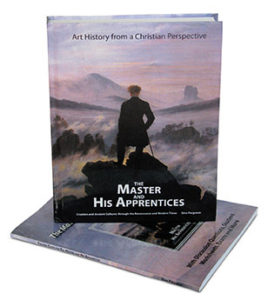The Master and His Apprentices – Revised 2021 Edition
The Master and His Apprentices: Art History from a Christian Perspective was initially published for the 2018-2019 school year. Since its release, the curriculum has received phenomenal feedback from readers worldwide, including winning the 2018 Blue Ribbon Award for “Favorite High School Product” from The Old Schoolhouse Homeschool Review Crew.
Not only have readers resoundingly appreciated the unique God-centered approach of The Master and His Apprentices, but a few have even graciously pointed out several areas for improvement. Using this feedback, we have revised both the textbook and teacher guide (digital and physical editions).
It is not unusual for publishers to release updates, either as a new printing or revised edition. This is done to correct typos or make minor changes, often, without notice to readers. However, we have chosen to share this information, particularly the content changes, so that readers can have the most accurate information available.
Revising the First Edition
First, it should be noted that these modifications are minor and therefore do not qualify as a new edition or require a change in ISBNs. However, readers can determine the difference in versions by viewing the copyright information. Original copies contain a line stating “First Edition,” while revised copies now display “First Edition (with a minor 2021 revision).”
You will begin seeing these changes in all digital editions as of today. Changes to physical editions will appear sometime in spring/summer 2022, depending on a store’s stock. Teachers do not need to worry about students using both versions together in a classroom as the changes are minor, and the content is still easy to follow for class readings.
So what are these changes?
Grammar
The majority of changes are grammatical. Initially, our writer and head editor had contrasting American and British backgrounds, which resulted in many spelling and punctuation inconsistencies. We have now standardized the grammar for American English. Furthermore, we have dropped the serial or series comma (also called the Oxford or Harvard comma), as this sometimes added confusion in longer, more complex sentences.
In addition, many different style guides and fields have contrasting guidelines for various grammatical points. Because The Master and His Apprentices crosses so many of these fields (with the added layer of a biblical perspective), we have worked hard to create a consistent style for The Master and His Apprentices that emphasizes art history and biblical writings over other influences. For instance, we have taken the position of capitalizing all pronouns related to the Trinity. We have also dropped the additional “s” when referencing a possessive case for Jesus or Moses but retained it elsewhere (e.g., Jesus’ vs. Ruebens’s).
Furthermore, when there are several commonly used spellings for a word, we have used the art history variation (e.g., colosseum instead of coliseum or coloseum). There were also many cases where we switched out a synonym word for variety or modified sentence construction slightly to achieve a smoother read.
Content
There are very few content changes, and the following list provides an overview of modifications resulting in “major” changes:
- We have modified or removed all references to high schoolers/teenagers as the curriculum is also being used in colleges.
- In Chapter 1 (on page 3), we have corrected the reference to two artists being called by God for the building of Solomon’s Temple as it was just one, Hiram of Tyre. We have also clarified the reference to this same Hiram of Tyre in the biblical quote from II Chronicles 2:13, which refers to him as Hiram-abi, by inserting [Hiram of Tyre] alongside the reference. [Question #14 for “Week 1” in the Teacher Guide has also been updated to reflect this change.]
- In Chapter 3 (on page 25), we changed the page reference for the Great Pyramid from pages 64 to 65. Originally, we had references refer to the first page of a “main section,” in this case, “pyramids.” Still, as one reader pointed out, page references should correspond with the page number on which the phrase first appears, rather than the section as a whole. [You will, therefore, see a few other page numbers modified slightly for similar reasons.]
- In Chapter 4 (on page 74), we changed “1992” to “1922” regarding King Tut’s tomb discovery.
- In Chapter 17 (on page 294), we have added a reference to Rubens’s “Rubenesque” style and its influence on later generations of artists.
- In the Appendix (pages 332-333), we have reworked the essay titled “The Israelite Sojourn in Egypt: 430 Years, 400 Years or Less?” to clarify better the difference in the 430, 400 and 215-year references. We did this by inserting a “summary” at the top that introduces the main points. We then reworded parts of the essay to parallel this introduction.
In Conclusion
Overall, both grammar and content changes are minor and affect far less than 1% of the book. Nevertheless, we are releasing the First Edition (with a minor 2021 revision) to keep The Master and His Apprentices as accurate and professional as possible. We greatly appreciate the feedback we have received so far and encourage you to continue contacting us with any additional feedback you may have!
If you aren’t using the curriculum already, you can find more for homeschoolers, here, and private schools here.
As always, whichever copy you are using, we pray that The Master and His Apprentices is a blessing to your family and/or school!
